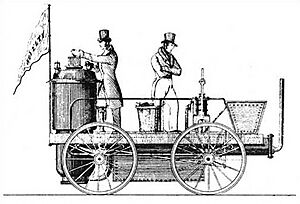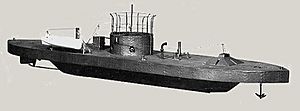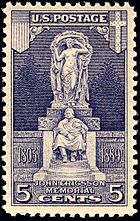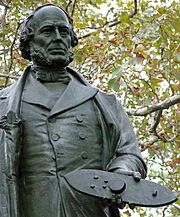John Ericsson facts for kids
Quick facts for kids
John Ericsson
|
|
|---|---|
 |
|
| Born |
Johan Ericsson
July 31, 1803 |
| Died | March 8, 1889 (aged 85) New York City, New York, U.S.
|
| Nationality | Swedish, American |
| Citizenship | Sweden; United States (1848–1889) |
| Occupation | Engineer, inventor, innovator |
| Signature | |
John Ericsson (born Johan Ericsson; July 31, 1803 – March 8, 1889) was a brilliant Swedish-American inventor and engineer. He worked in both England and the United States.
Ericsson helped design the famous steam locomotive Novelty. This train competed in the Rainhill Trials in England. Later, in America, he designed the United States Navy's first ship with a screw propeller, USS Princeton.
He is most famous for designing USS Monitor. This was an armored ironclad warship with a spinning gun turret. The Monitor played a key role in the American Civil War. It saved the U.S. Navy from a powerful Confederate ship, CSS Virginia, at the Battle of Hampton Roads in 1862.
Contents
Early Life and Work
Johan Ericsson was born in Långban, Filipstad Municipality, Värmland, Sweden. His older brother, Nils Ericson, became a famous builder of canals and railways in Sweden. Their father, Olaf Ericsson, worked as a supervisor in a mine.
In 1810, his family moved to Forsvik. There, his father directed blasting work for the Göta Canal. The boys' amazing skills were noticed by Baltzar von Platen, who designed the canal. They became "cadets of mechanics" for the Swedish Royal Navy.
At just 14, John was already working as a surveyor on his own. He was so short that his assistant had to carry a footstool for him to reach his tools!
At 17, he joined the Swedish army as a Second Lieutenant. He was soon promoted to Lieutenant. While surveying in northern Sweden, he worked on a heat engine. This engine used fumes from a fire instead of steam. His love for machines led him to leave the army in 1826 and move to England.
His first heat engine didn't work well in England. It was designed for burning birch wood, but England mainly used coal.

Despite this setback, Ericsson invented many other steam-powered machines. He improved heating by adding bellows to increase air to the fire. In 1829, he and English engineer John Braithwaite built the Novelty locomotive. It competed in the Rainhill Trials for the Liverpool and Manchester Railway. The Novelty was praised but had boiler problems. The competition was won by George Stephenson's Rocket.
Braithwaite and Ericsson built two more engines, William IV and Queen Adelaide. These were larger and stronger. They also built an innovative steam fire engine. This engine successfully put out a large fire in London in 1830. It worked for five hours when other engines froze!
One of Ericsson's most successful early inventions was the surface condenser. This device allowed steamships to reuse fresh water for their boilers while at sea. He also invented a "deep sea lead" to measure ocean depth.
During this time, Ericsson faced financial difficulties. He also married Amelia Byam, but they later separated. In 1877, he became a member of the American Philosophical Society.
Education and Learning
John Ericsson's only formal schooling was basic officer training in the Swedish Army. In 1822, he passed a surveyor's exam in Stockholm. As a child, his father taught him about mining and surveying.
Innovations in Propeller Design
Ericsson greatly improved ship design. He created a system with two screw-propellers turning in opposite directions. The British Navy didn't approve of his idea. However, an American captain named Robert Stockton was interested.
Stockton invited Ericsson to bring his invention to the United States. Ericsson moved to New York in 1839. Stockton wanted Ericsson to develop a new type of warship. Finally, funds were approved for a new ship. It was a smaller ship called a sloop, not a large frigate. This ship became USS Princeton, named after Stockton's hometown.
The Princeton took about three years to build. It was perhaps the most advanced warship of its time. It had twin screw propellers. It also had a large 12-inch gun on a spinning platform. Ericsson designed this gun too. It used a special "hoop construction" to make it stronger and safer. Other new features included a collapsible funnel and an improved recoil system.
Relations between Ericsson and Stockton became difficult. Stockton tried to take all the credit for the ship. He even designed a second gun for the Princeton. But Stockton didn't understand Ericsson's design. His second gun was faulty.
When launched, the Princeton was a huge success. In 1843, it won a speed race against the SS Great Western, then the fastest steamer. Sadly, during a firing test of Stockton's faulty gun, it exploded. This accident killed important government officials, including the Secretary of State and the Secretary of the Navy. Stockton tried to blame Ericsson, even though Ericsson's gun was safe. Stockton also refused to pay Ericsson for his work.
Working with Cornelius H. DeLamater
When Ericsson moved to New York City, he met industrialist Cornelius H. DeLamater. They quickly became close friends and business partners. Ericsson often called DeLamater "Harry."
The DeLamater Iron Works became a place where Ericsson could freely experiment. They built the Iron Witch, the first iron steamboat. They also built the ship Ericsson, which used Captain Ericsson's first hot-air engine. The DeLamater Iron Works also launched the first submarine boat, the first self-propelled torpedo, and the first torpedo boat.
When DeLamater died in 1889, Ericsson was heartbroken. Ericsson himself passed away just one month later.
Hot Air Engines
Ericsson also invented the caloric, or hot air, engine in the 1820s. This engine used hot air instead of steam. A similar engine had been patented earlier by Robert Stirling, which is why they are often called 'Stirling Engines'. Ericsson's first hot air engine didn't work well with coal.
Despite problems, Ericsson received the Rumford Prize in 1862 for his invention. In 1830, he patented a second engine that could use steam, air, or water. In 1833, he built a third hot air engine. This engine included a "regenerator" that reused heat, inspiring many other inventors.
In 1852, a large "caloric ship" named Ericsson was built. It was powered by Ericsson's fourth engine design. New York merchants and bankers supported the project. The ship and engine were built in secret. They hoped it would change ocean travel with its low cost and safety.
The ship was launched in September 1852. The engine was tested in November. However, the large ship's engine was a failure. Smaller test engines based on the same design had worked well.
Later in his life, the caloric engine made Ericsson quite wealthy. Its design, without a boiler, was safer and more practical for small factories than steam engines. Ericsson's "regenerator" made his engine very fuel-efficient.
In 1883, John Ericsson built a solar air engine. This engine used mirrors to focus the sun's rays onto a heater. This heat then powered the engine. He showed that solar energy could be used to create power.
Ship Designs and the Monitor
On September 26, 1854, Ericsson showed Napoleon III of France drawings of armored battleships. These ships had a dome-shaped gun tower. The French emperor liked the plan but did not build it. In 1851, Ericsson also designed the Caloric ship Ericsson.
The USS Monitor
When the American Civil War began in 1861, the Confederacy started building an ironclad ship. They used the hull of USS Merrimack. At the same time, the United States Congress decided to build armored ships for the U.S. Navy.
Ericsson didn't like the U.S. Navy because of his past problems with Stockton. But Gideon Welles, the Secretary of the Navy, and Cornelius Scranton Bushnell convinced him. Ericsson submitted drawings for USS Monitor. This was a new kind of armored ship with a rotating turret holding two large cannons.
Despite arguments over its unique design, the Monitor was built quickly. It went from plans to launch in about 100 days! It was launched on March 6, 1862.
On March 8, the Confederate ironclad, now called CSS Virginia, attacked the Union fleet. It sank two Union ships. The next day, March 9, 1862, the Monitor appeared. This led to the first battle between ironclad warships at Hampton Roads, Virginia. The battle was a tie; neither ship could sink the other. But the Monitor saved the rest of the Union fleet.
After this, many more "monitors" were built for the Union. They helped the Union win the naval war. The Monitor's rotating gun turret was a huge step forward in naval history. This design is still used on warships today!
Later Inventions
Later, Ericsson designed other naval vessels and weapons. These included a type of torpedo and a destroyer. The destroyer was a torpedo boat that could fire a cannon from underwater. He also helped John Philip Holland with his early submarine experiments.
In his book Contributions to the Centennial Exhibition (1877), he showed his "sun engines." These engines collected solar heat to power a hot air engine. One of these designs later earned Ericsson more money when it was changed to run on methane gas.
Key Inventions
- The surface condenser
- The hot air engine
- The world's first monitor warship, USS Monitor
- Advanced torpedo technology, like the Destroyer torpedo boat
- The solar machine, which used mirrors to gather sunlight for an engine
- USS Princeton (1843)
- Hoop gun construction, making cannons stronger
- The screw propeller for ships
Awards and Honors
- Foreign member of the Royal Swedish Academy of Sciences in 1850 (Swedish member from 1863)
- Royal Swedish Academy of War Sciences in 1852
- Honorary Doctorate from Lund University in 1868
Monuments and Memorials
A stamp honoring John Ericsson was released on April 20, 1926. This was for the unveiling of the Ericsson Memorial in West Potomac Park, Washington, DC. The stamp shows the memorial's design. It features a seated Ericsson with figures representing Vision, Labor, and Adventure.
Monuments honoring John Ericsson can be found at:
- John Ericsson National Memorial on The Mall in Washington, D.C.
- John Ericsson Room at the American Swedish Historical Museum in Philadelphia
- John Ericsson Statue in Battery Park in New York City. A public middle school in Greenpoint, Brooklyn, is also named after him.
- Nybroplan in Stockholm, Sweden
- Kungsportsavenyn in Gothenburg, Sweden
- John Ericsson Street in Lund, Sweden
- John Ericsson fountain, Fairmount Park, Philadelphia
- The neighborhood of Ericsson, Minneapolis
- Långbanshyttan, his birthplace in Sweden
Ships named in his honor:
- USS Ericsson
Organizations:
- The John Ericsson Republican League of Illinois is a Swedish-American group.
Mount Ericsson, a mountain peak in California's Sierra Nevada mountains, is also named for him.
See also
 In Spanish: John Ericsson para niños
In Spanish: John Ericsson para niños
- Independence (steamboat), the first steamboat on the Great Lakes, used Ericsson's propellers.
- American Swedish Historical Museum, John Ericsson Room
- Experiment (horse powered boat)
- HSwMS Sölve – a Swedish monitor ship built in 1875 and designed by Ericsson. It is now in a Maritime Museum in Gothenburg, Sweden.
- Ericsson cycle, a thermodynamic cycle for heat engines named after John Ericsson.
- Ericsson Line







